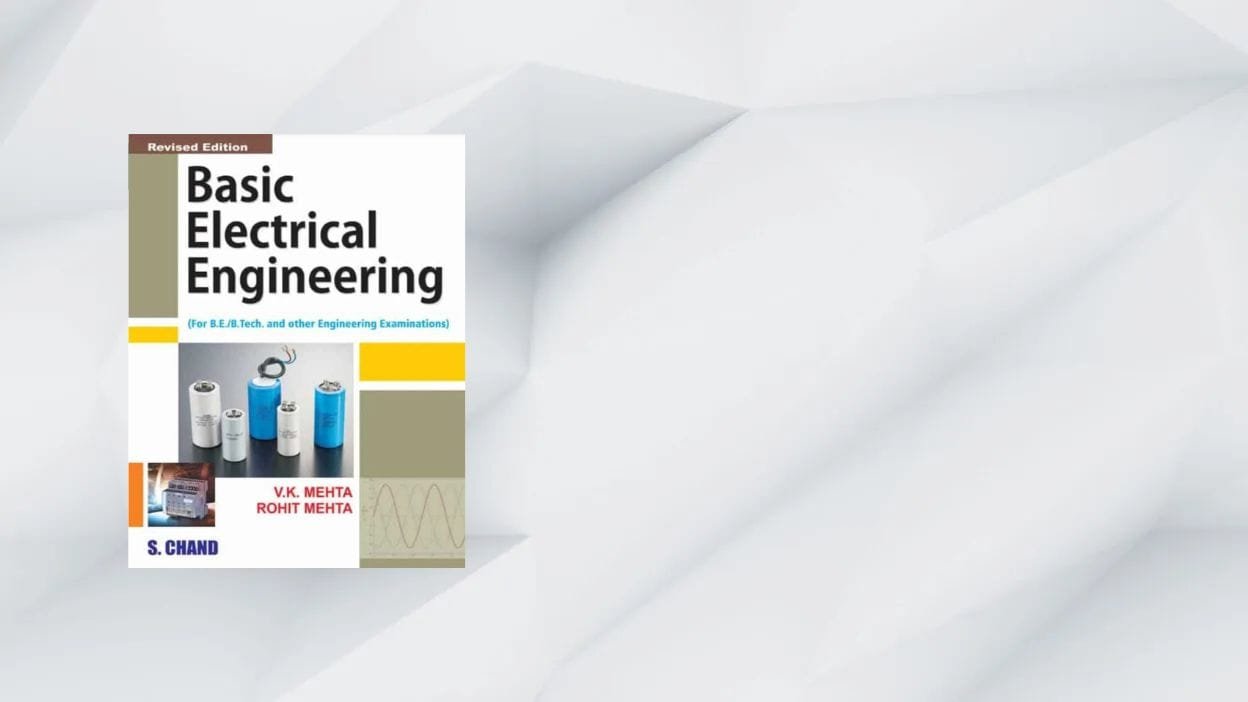Few Indian textbooks have shaped first-year engineering curricula as decisively as D. P. Kothari & I. J. Nagrath’s Basic Electrical Engineering. The Revised Edition (McGraw-Hill Education, 2015 re-reprint; ISBN 978-0-07-014611-2) freshens the classic with updated SI units, solved GATE-style numericals and a brand-new chapter on renewable-energy interfaces. Spanning 832 pages, it remains a go-to primer for B.Tech, diploma and AMIE aspirants alike.
Book at a Glance
| Full Title | Basic Electrical Engineering – Revised Edition |
| Authors | D. P. Kothari (Ex-VC, VIT) & I. J. Nagrath |
| Publisher / Year | McGraw-Hill Education • 2015 reprint |
| Length | 832 pp. • 1 200+ line diagrams |
| ISBN-13 | 9780070146112 |
| Formats | Paperback • eBook (McGrawHill e-Reader) |
| Price | ₹695 (India); ≈ US $40 international |
| Audience | First-year B.E./B.Tech, diploma, GATE & SSC-JE prep, self-learners |
Why Basic Electrical Engineering Revised Edition Still Matters
- Syllabus-ready structure – Chapters map directly to AICTE and most state-technical-university modules, so lecturers can “assign a chapter a week” with zero reshuffle.
- Balanced theory & numericals – Concise derivations lead straight to solved examples, followed by graded end-questions (objective, short-answer, long-answer) to cement learning.
- Modern context – The revised print adds a renewable-energy overview (PV, small-wind, micro-hydro) plus power-quality snapshots—essential for today’s smart-grid mindset.
- Exam-oriented extras – GATE/IES hints, past-paper references and 300+ multiple-choice questions make last-minute revision painless.
Chapter Highlights
| Ch. | Topic | Key Take-away Skills |
|---|---|---|
| 1 | Fundamentals | Master SI units, charge, current, energy & power relations |
| 2 | DC Network Theorems | Apply KCL/KVL, Thevenin, Norton and superposition with confidence |
| 3 | Magnetic Circuits & Transformers | Convert between electrical & magnetic analogies; analyse core losses |
| 4 | AC Fundamentals | Interpret phasors, rms/average values, complex power & PF improvement |
| 5 | Three-Phase Systems | Perform star-delta conversions, line/phase analyses, symmetrical components intro |
| 6 | DC Machines | Derive EMF equations, torque/speed curves; predict efficiency |
| 7 | Induction & Synchronous Machines | Slip, equivalent circuits, V-curves, regulation by EMF-MMF methods |
| 8 | Special Machines & Drives | Stepper, BLDC, universal motors & intro to V/f inverters |
| 9 (NEW) | Renewable-Energy Interfaces | Grid-tie inverters, MPPT basics, standalone DC nano-grids |
| Appendices | Standard wire gauges, GATE formula sheet, answers to odd problems |
Stand-out Strengths
- Crystal-clear diagrams – 1 200+ redrawn line figures minimise cognitive load; colour-keyed phasors remove sign-confusion.
- Step-by-step numericals – Every solved example shows intermediate values, units and calculator keystrokes—great for beginners.
- Pedagogical aids – Lecture outlines, “Key Concept” boxes and “At a Glance” summaries speed up revision.
- Affordable & widely available – Indian print cost stays below ₹700, and pirated PDFs are virtually unnecessary thanks to the publisher’s low-priced e-book.
Limitations
| Limitation | Impact | Work-around |
|---|---|---|
| Dense page count | 800+ pages can overwhelm one-semester schedules | Use publisher’s companion slides for selective teaching |
| Limited electronics | Power-electronics coverage is just a teaser | Pair with Dubey’s Power Electronics for depth |
| Minimal simulation tips | No SPICE/MATLAB walkthroughs | Ask faculty to set lab tasks mirroring textbook numericals |
Comparison Snapshot
| Feature | Kothari & Nagrath (Rev.) | Basic Electrical Engg. (V.K. Mehta 2014) | Fundamentals of EE (Bobrow 2011) |
|---|---|---|---|
| Pages | 832 | 750 | 912 |
| Renewables chapter | ✔ | ✖ | ✔ (brief) |
| GATE/IES extras | ✔ | Moderate | ✖ |
| International units | Pure SI | SI + Imperial | SI |
| Best for | Indian B.Tech & skill exams | Diploma & ITI | U.S. freshmen |
FAQ
| Is the revised edition beginner-friendly? | Yes—math tops out at basic calculus; class-XI physics is enough to start. |
| Are solutions provided? | Odd-number answers + full worked examples; solutions manual for instructors via McGraw-Hill. |
| Does it help with GATE EE? | Conceptually yes; combine with a dedicated MCQ bank for timed practice. |
| Where to buy? | Amazon India, major campus bookstores, McGraw-Hill e-reader app (DRM-free PDF). |

